Sedimentary Characteristics of Lacustrine Beach-Bars and Their Formation in the Paleogene Weixinan Sag of Beibuwan Basin, Northern South China Sea
Abstract
1. Introduction
2. Geological Background
3. Materials and Methods
4. Results
4.1. Sedimentary Characteristics
4.1.1. Lithology
4.1.2. Mineral Composition
4.1.3. Sedimentary Structures
4.1.4. Geophysical Characteristics
4.2. Distribution Pattern of Beach-Bar Sand Bodies
5. Discussion
5.1. Formation Mechanism
5.1.1. Paleotopography
5.1.2. Hydrodynamic Environment
5.1.3. Sediment Provenance
5.1.4. Lake Level Oscillations
5.2. Depositional Model of Lacustrine Beach-Bars
6. Conclusions
Supplementary Materials
Author Contributions
Funding
Institutional Review Board Statement
Informed Consent Statement
Data Availability Statement
Acknowledgments
Conflicts of Interest
References
- Basilici, G. Sedimentary facies in an extensional and deep-lacustrine depositional system: The Pliocene Tiberino Basin, Central Italy. Sediment. Geol. 1997, 109, 73–94. [Google Scholar] [CrossRef]
- Jiang, Z.; Liu, H.; Zhang, S.; Su, X.; Jiang, Z. Sedimentary characteristics of large-scale lacustrine beach-bars and their formation in the Eocene Boxing Sag of Bohai Bay Basin, East China. Sedimentology 2011, 58, 1087–1112. [Google Scholar] [CrossRef]
- Monroe, S. Late Oligocene-early Miocene facies and lacustrine sedimentation, upper Ruby River basin, Southwestern Montana. J. Sediment. Res. 1981, 51, 939–951. [Google Scholar]
- Song, F.; Su, N.N.; Yang, S.C.; Yao, R.X.; Chu, S.M. Sedimentary characteristics of thick layer lacustrine beach-bars in the Cenozoic Banqiao Sag of the Bohai Bay Basin, East China. J. Asian Earth Sci. 2018, 151, 73–89. [Google Scholar] [CrossRef]
- Soreghan, M.J.; Cohen, A.S. Textural and compositional variability across littoral segments of Lake Tanganyika: The effect of asymmetric basin structure on sedimentation in large rift lakes. AAPG Bull. 1996, 80, 382–409. [Google Scholar]
- Zhu, X.M.; Xin, Q.L.; Zhang, J.R. Sedimentary characteristics and models of the beach-bar reservoirs in faulted down lacustrine basins. Acta Sedimentol. Sin. 1994, 12, 20–27, (In Chinese with English Abstract). [Google Scholar]
- Otvos, E.G. Beach ridges definitions and significance. Geomorphology 2000, 32, 83–108. [Google Scholar] [CrossRef]
- Tamura, T. Beach riges and prograded beach deposits as palaeoenvironment records. Earth-Sci. Rev. 2012, 144, 279–297. [Google Scholar] [CrossRef]
- Reid, I.; Frostick, L.E. Beach orientation, bar morphology and the concentration of metalliferous placer deposits: A case study, Lake Turkana, N Kenya. J. Geol. Soc. 1985, 142, 837–848. [Google Scholar] [CrossRef]
- Williamson, C.R.; Picard, M.D. Petrology of carbonate rocks of the Green River Formation (Eocene). J. Sediment. Res. 1974, 44, 738–759. [Google Scholar]
- Deng, H.; Xiao, Y.; Ma, L.; Jiang, Z. Genetic type, distribution patterns and controlling factors of beach and bars in the second member of Shahejie Formation in the dawanbei sag, Bohai Bay, China. Geol. J. 2011, 46, 380–389. [Google Scholar]
- Gao, X.; Deng, H.; Lin, H. Stratigraphic controls on the evolution and distribution of lacustrine beach and bar Sands-Bohai Bay basin in China. Manuf. Eng. Environ. Eng. 2014, 84, 1513–1519. [Google Scholar]
- Goulart, E.S.; Calliari, L.J. Medium-term morphodynamic behavior of a multiple sand bar beach. J. Coast. Res. 2013, 65, 1774–1779. [Google Scholar] [CrossRef][Green Version]
- Wang, J.; Cao, Y.; Liu, K.; Wang, X.; Xiao, J.; Xie, N. Mass transfer between mudstone-sandstone interbeds during diagenesis as revealed from the type and distribution of carbonate cements in the Eocene beach-bar sandstones, Bohai Bay Basin. Mar. Petrol. Geol. 2019, 110, 21–34. [Google Scholar] [CrossRef]
- Zhao, Y.; Wang, H.; Yan, D.; Jiang, P.; Chen, S.; Zhou, J.; Zhao, Y. Sedimentary characteristics and model of gravity flows in the Eocene Liushagang Formation in Weixi’nan depression, South China Sea. J. Petrol. Sci. Eng. 2020, 190, 107082. [Google Scholar] [CrossRef]
- Cao, L.; Zhang, Z.; Li, H.; Zhong, N.; Xiao, L.; Jin, X.; Li, H. Mechanism for the enrichment of organic matter in the Liushagang Formation of the Weixinan Sag, Beibuwan Basin, China. Mar. Petrol. Geol. 2020, 122, 104649. [Google Scholar] [CrossRef]
- Huang, B.J.; Tian, H.; Wilkins, R.W.T.; Xiao, X.M.; Li, L. Geochemical characteristics, palaeoenvironment and formation modelof Eocene organic-rich shales in the Beibuwan Basin, South China Sea. Mar. Petrol. Geol. 2013, 48, 77–89. [Google Scholar] [CrossRef]
- Xie, J.Y.; Li, J.; Mai, W.; Zhang, H.L.; Cai, K.L.; Liu, X.Y. Palynofloras and age of the Liushagang and Weizhou formations in the Beibuwan Basin, south China sea. Acta Palaeontol. Sin. 2012, 51, 385–394. [Google Scholar]
- Xu, X.D.; Wang, B.W.; Li, X.H.; Liu, M.Q.; Zhang, Y.Z.; Hang, B.J. Oil sources of concealed reservoirs in Liushagang formations of the Weixi’nan sag and accumulation feature, Beibuwan Basin. Nat. Gas Geosci. 2012, 23, 92–98. [Google Scholar]
- Zhou, X.; Gao, G.; Lü, X.; Zhao, L.; Dong, Y.; Xu, X.; Gan, J. Petroleum source and accumulation of WZ12 oils in the Weixi’nan sag, South China Sea, China. J. Petrol. Sci. Eng. 2019, 177, 681–698. [Google Scholar] [CrossRef]
- Huang, B.J.; Xiao, X.M.; Cai, D.S.; Wilkins, R.W.T.; Liu, M.Q. Oil families and their source rocks in the weixinan sub-basin, Beibuwan basin, South China Sea. Org. Geochem. 2011, 42, 134–145. [Google Scholar] [CrossRef]
- Gao, G.; Zhou, X.X.; Dong, Y. Detailed research of petroleum generation and accumulation in Liushagang Formation of Weixi’nan Sag, Beibuwan Basin (Internal Report of Zhanjiang Branch of the China National Offshore Oil Company); China National Offshore Oil Company: Zhanjiang, China, 2014. [Google Scholar]
- Luo, B.H.; He, J.; Jiang, P.; Qin, C.Y.; Yang, X.B.; Lu, J.; Zhao, Y.P. Sedimentary Characteristics of Lacustrine Beach-bars and Their Formation of the Second Member of Liushagang Formation in the Paleogene Weixinan Sag of Beibuwan Gulf Basin, Northern South China Sea. Geol. Sci. Technol. Inf. 2019, 38, 186–196, (In Chinses with English Abstract). [Google Scholar]
- He, J.; Wang, H.; Tang, J.; Shangguan, Y.; Yang, X.; Gong, Y.; Zhao, R.; Zhou, X. Evaluation of lacustrine mudstone top sealing capacity in the Lenghu-5 area, Qaidam Basin, Tibetan Plateau. J. Petrol. Sci. Eng. 2020, 188, 106973. [Google Scholar] [CrossRef]
- Gao, Z.; Yang, X.; Hu, C.; Wei, L.; Jiang, Z.; Yang, S.; Fan, Y.; Xue, Z.; Yu, H. Characterizing the pore structure of low permeability Eocene Liushagang Formation reservoir rocks from Beibuwan Basin in northern South China Sea. Mar. Petrol. Geol. 2019, 99, 107–121. [Google Scholar]
- Hao, F.; Zhou, X.H.; Zhu, Y.M.; Bao, X.H.; Yang, Y.Y. Mechanisms for oil depletion and enrichment on the Shijiutuo uplift, Bohai Bay Basin, China. AAPG Bull. 2009, 93, 1015–1037. [Google Scholar] [CrossRef]
- Wang, J.; Cao, Y.C.; Li, J.L. Sequence structure and non-structural traps of the Paleogene in the Weixi’nan Sag, Beibuwan Basin. Pet. Explor. Dev. 2012, 39, 325–334. [Google Scholar] [CrossRef]
- Wang, J.; Cao, Y.C.; Li, J.L.; Yue, Y.X. Distribution of beach-bar sandbodies of the second member of Liushagang Formation of Paleogene of south slope in Weixinan Depression, Beibuwan Basin. Acta Sedimentol. Sin. 2013, 31, 536–544, (In Chinese with English Abstract). [Google Scholar]
- Liu, P.; Xia, B.; Tang, Z.Q.; Wang, X.G.; Zhang, Y. Fluid inclusions in reservoirs of Weixinan Sag, Beibuwan Basin. Petrol. Explor. Dev. 2008, 35, 164–200. [Google Scholar] [CrossRef]
- Liu, Y.; Wu, Z.; Liu, L.; Yan, S.; Hu, L.; Ping, M.; Zhang, M. Cenozoic structure and tectonics of North subbasins in Beibu Gulf Basin, northern South China Sea. Tectonophysics 2021, 812, 228912. [Google Scholar] [CrossRef]
- Liu, E.; Wang, H.; Li, Y.; Zhou, W.; Leonard, N.D.; Lin, Z.; Ma, Q. Sedimentary characteristics and tectonic setting of sublacustrine fans in a half-graben rift depression, Beibuwan Basin, South China Sea. Mar. Petrol. Geol. 2014, 52, 9–21. [Google Scholar] [CrossRef]
- Vail, P.R.; Audemard, F.; Bowman, S.A. The stratigraphic signatures of tectonics, eustasy and sedimentology—An overview. In Cycles and Events in Stratigraphy; Springer: Berlin/Heidelberg, Germany, 1991; Volume 6, pp. 7–659. [Google Scholar]
- Scherer, C.M.; Lavina, E.L.; Dias Filho, D.C.; Oliveira, F.M.; Bongiolo, D.E.; Aguiar, E.S. Stratigraphy and facies architecture of the fluvial-Aeolian-lacustrine Sergi Formation (Upper Jurassic), Reconcavo Basin, Brazil. Sediment. Geol. 2007, 194, 169–193. [Google Scholar] [CrossRef]
- Garzanti, E. Petrographic classification of sand and sandstone. Earth-Sci. Rev. 2019, 192, 545–563. [Google Scholar] [CrossRef]
- Schwartz, R.K. Bedform, texture, and longshore bar development in response to combined storm wave and current dynamics in a nearshore helical flow system. J. Coast. Res. 2012, 28, 1512–1535. [Google Scholar] [CrossRef]
- Short, A.D. Multiple offshore bars and standing waves. J. Geophys. Res. 1975, 80, 3838–3840. [Google Scholar] [CrossRef]
- Yang, Y.Q.; Qiu, L.W.; Jiang, Z.X.; Yin, X.L. A depositional pattern of beach bar in continental rift lake basins: A case study on the upper part of the fourth member of the Shahejie Formation in the Dongying Sag. Acta Petrol. Sin. 2011, 32, 417–423. [Google Scholar]
- Lin, H.X.; Deng, H.W.; Qin, Y.Q.; Gao, X.P.; Long, G.Q.; Zhao, N.; Yan, H.; Pan, F.Y.; Di, Y.X. Control of sequence stratigraphic evolution on the distribution and hydrocarbon accumulation of beach and bar reservoirs. Petrol. Expl. Dev. 2010, 37, 680–689, (In Chinese with English Abstract). [Google Scholar]
- Distefano, S.; Gamberi, F.; Baldassini, N.; Di Stefano, A. Neogene stratigraphic evolution of a tectonically controlled continental shelf: The example of the Lampedusa island. Ital. J. Geosci. 2019, 138, 418–431. [Google Scholar] [CrossRef]
- Guo, S. The influence of the pre-existing topography on the depositionary systems, the development of the Lower Jurassic reservoirs and hydrocarbon accumulation in Central Western Ordos Basin. J. Petrol. Sci. Eng. 2010, 75, 129–134. [Google Scholar] [CrossRef]
- Paul, J.M.; Peter, M.I.; Dale, A.L. Use of micromorphology for palaeoenvironmental interpretation of complex alluvial palaeosols: An example from the MillCreek Formation (Albian), southwestern Alberta, Canada. Palaeogeogr. Palaeoclimatol. Palaeoecol. 1998, 143, 87–110. [Google Scholar]
- Zhu, X.M.; Liu, Q.H.; Ge, J.W.; Dong, Y.L.; Zhu, S.F.; Tan, M.X.; Yang, Y. Reconstruction of sediment-dispersal patterns using seismic sedimentology in the southeastern Zhanhua Sag, Bohai Bay Basin, China. J. Petrol. Sci. Eng. 2019, 182, 106335. [Google Scholar]
- Jiang, Z.X.; Wang, J.H.; Zhang, Y.F. Advances in beach-bar research: A review. J. Palaeogeogr. 2015, 17, 427–440, (In Chinese with English Abstract). [Google Scholar]
- Graham, J.P. Revised stratigraphy, depositional systems, and hydrocarbon exploration potential for the lower Cretaceous muddy sandstone. Northern Denver Basin. AAPG Bull. 2000, 84, 183–209. [Google Scholar]
- Wang, J.; Xu, S.; Yu, J.; Han, W.; Cui, H.; Zhai, Y. Prediction of beach-bar sand reservoirs using waveform analysis: A case study on Es4s in the west area of the Dongying sag. Earth Sci. J. Chin. Univ. Geosci. 2008, 33, 627–633. [Google Scholar]
- Zhang, Y.; Hu, C.; Wang, M.; Ma, M.; Wang, X.; Jiang, Z. A quantitative sedimentary model for the modern lacustrine beach bar (Qinghai Lake, Northwest China). J. Paleolimnol. 2018, 59, 279–296. [Google Scholar] [CrossRef]
- Gao, Y.F.; Peng, S.P.; He, H.; Kong, W. Reservoir characters and evaluation of the Tertiary clastic sediments in the Northern Qaidam basin, Northwest. China. Petrol. Expl. Dev. 2003, 30, 40–42. [Google Scholar]
- Keighley, D.; Flint, S.; Howell, J.; Moscarliello, A. Sequence stratigraphy in lacustrine basin: A model for part of the Green River Formation (Eocene), Southwest Uinta Basin, Utah, USA. J. Sediment. Petrol. 2003, 73, 987–1006. [Google Scholar] [CrossRef]
- Cook, D.O. The occurrence and geologic work of rip currents of southern California. Mar. Geol. 1970, 9, 173–186. [Google Scholar] [CrossRef]
- Huang, E.; Tian, J.; Steinke, S. Millennial-scale dynamics of the winter cold tongue in the southern South China Sea over the past 26ka and the East Asian winter monsoon. Quat. Res. 2011, 75, 196–204. [Google Scholar] [CrossRef]
- Schroeder, A.; Wiesner, M.G.; Liu, Z.F. Fluxes of clay minerals in the South China Sea. Earth Planet. Sci. Lett. 2015, 430, 30–42. [Google Scholar] [CrossRef]
- Zhu, X.M.; Zhong, D.K.; Yuan, X.J.; Zhang, H.L.; Zhu, S.F.; Sun, H.T.; Gao, Z.Y.; Xian, B.Z. Development of sedimentary geology of petroliferous basins in China. Petrol. Expl. Dev. 2016, 43, 890–901. [Google Scholar] [CrossRef]
- Xie, N.; Cao, Y.C.; Wang, J.; Jin, J.H.; Zhang, W.J.; Zhong, Z.H. Diagenesis and its control on physical property of the reservoirs in the 3rd member of the Paleogene Liushagang Formation in Weixinan Depression, Beibuwan Basin. Nat. Gas Geosci. 2019, 30, 1743–1754, (In Chinese with English Abstract). [Google Scholar]
- Gabriel, K.R. The biplot graphic display of matrices with application to principal component analysis. Biometrika 1971, 58, 453–467. [Google Scholar] [CrossRef]
- Comas Cufí, M.; Thió Fernández de Henestrosa, S. CoDaPack 2.0: A stand-alone, multi-platform compositional software. In CoDAWork’11: 4th International Workshop on Compositional Data Analysis, Sant Feliu De Guíxols; CoDAWork’11: Girona, Spain, 2011. [Google Scholar]
- Distefano, S.; Gamberi, F.; Baldassini, N.; Di Stefano, A. Quaternary evolution of coastal plain in response to sea-level changes: Example from south-east Sicily (Southern Italy). Water 2021, 13, 1524. [Google Scholar] [CrossRef]
- Carroll, A.R.; Bohacs, K.M. Lake type control on hydrocarbon source potential in nonmarine basins. AAPG Bull. 2001, 85, 1033–1053. [Google Scholar]
- Hou, F.H.; Jiang, Y.Q.; Fang, S.X.; Guo, G.A.; Yang, J.L. Sedimentary model of sandstone in second and fourth members of Xiangxi formation in the upper Triassic of Sichuan basin. Acta Petrol. Sin. 2005, 26, 30–37. [Google Scholar]
- Yuretich, R.F.; Hickey, L.J.; Gregson, B.P.; Hsia, Y.L. Lacustrine deposits in the Paleocene Fort Union Formation, Northern Bighorn Basin. Montana. J. Sediment. Petrol. 1984, 54, 836–852. [Google Scholar]
- Xia, S.; Lin, C.; Du, X.; Jia, D.; Ahmad, N.; Zhang, Z.; Gao, L.; Zhu, Y. Correspondences among lacustrine fluctuations, climate changes and the Milankovitch cycles in the Paleogene through tracking onlap points and correlating palaeontology in Liaozhong Depression, Bohai Bay Basin, NE China. Geol. J. 2020, 55, 6527–6543. [Google Scholar] [CrossRef]
- Milankovitch, M. Kanon der Erdbestrahlung und seine Anwendung auf das Eiszeitenproblem. Beogr. Königlich Serbische Akad. 1941, 32, 633. [Google Scholar]
- Bohacs, K.M.; Carroll, A.R.; Neal, J.E.; Mankiewicz, P.J. Lake-Basin type, source potential, and hydrocarbon character: An integrated sequence-stratigraphic-geochemical framework. In Lake Basins through Space and Time; Gierlowski-Kordesch, E.H., Kelts, K.R., Eds.; American Association of Petroleum Geologists: Tulsa, OK, USA, 2000; Volume 46, pp. 3–34. [Google Scholar]
- Cong, F.; Zhu, F.; Cai, Z.; Chen, H.; Li, J.; Wang, Y.; Wang, L. Orbitally forced glacio-eustatic origin of third-order sequences and parasequences in the Middle Permian Maokou Formation, South China. Mar. Petrol. Geol. 2019, 99, 237–251. [Google Scholar] [CrossRef]
- Liu, Q.; Zhu, H.; Shu, Y.; Zhu, X.; Yang, X.; Chen, L.; Tan, M.; Geng, M. Provenance identification and sedimentary analysis of the beach and bar systems in the Palaeogene of the Enping Sag, Pearl River Mouth Basin, South China Sea. Mar. Petrol. Geol. 2016, 70, 251–272. [Google Scholar] [CrossRef]
- Wang, Y.; Yang, S.; Zhang, Y.; Lu, Y.; Wang, Y.; Zhao, Y. Investigation of pore structure and reservoir quality of Eocene beach-bar sandstones in Dongying Depression, Bohai Bay Basin, East China. J. Petrol. Sci. Eng. 2020, 189, 106854. [Google Scholar] [CrossRef]
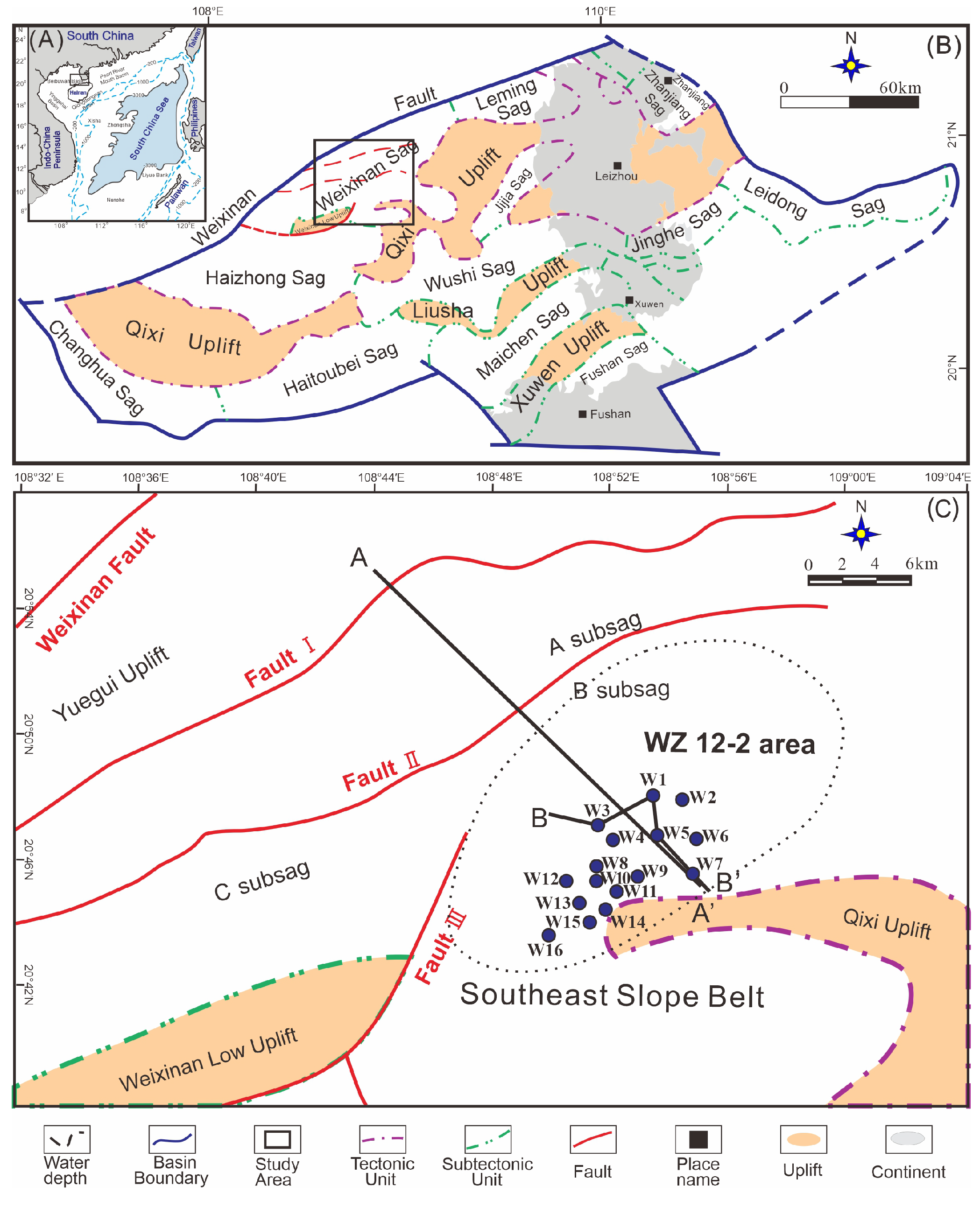
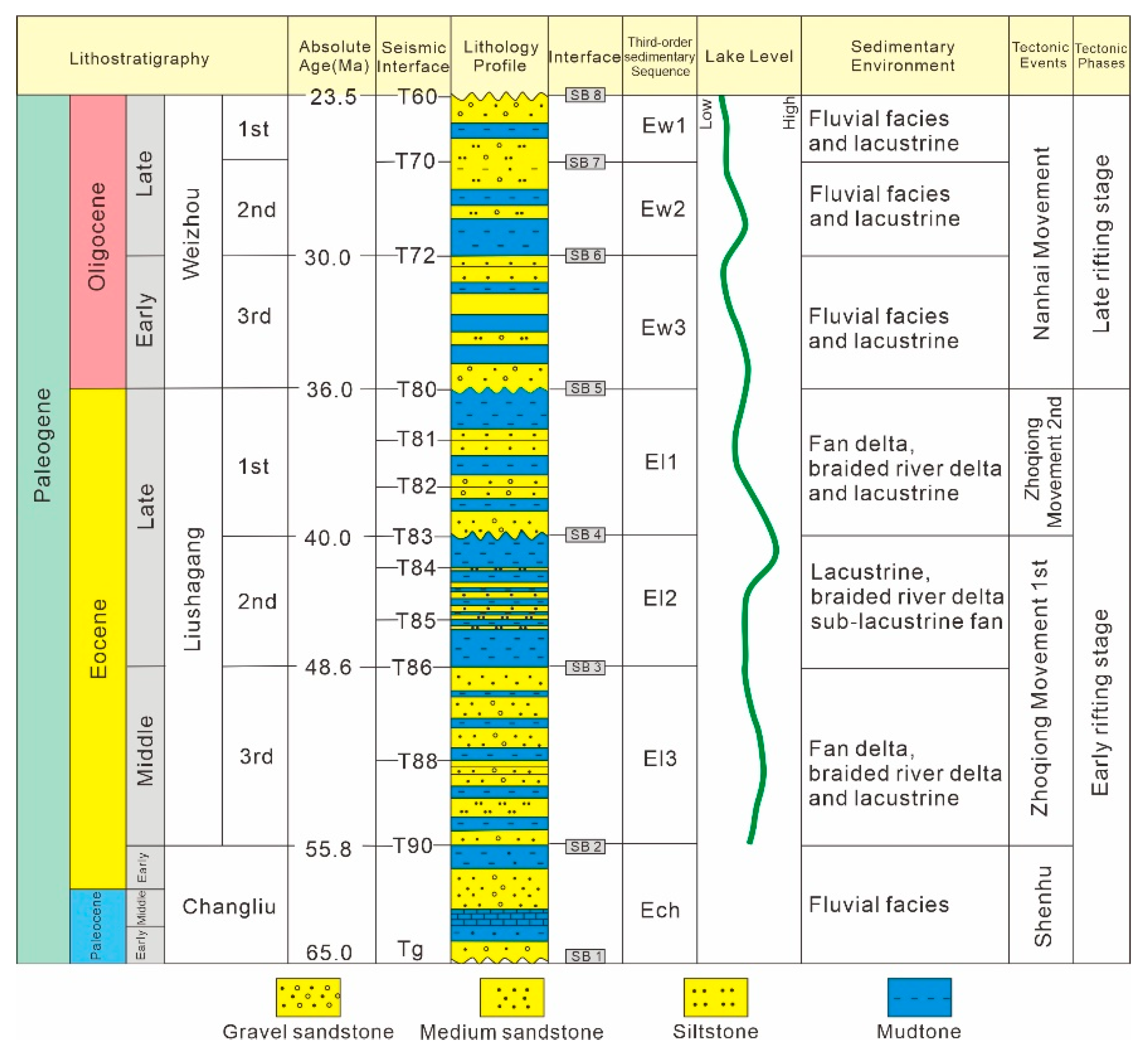

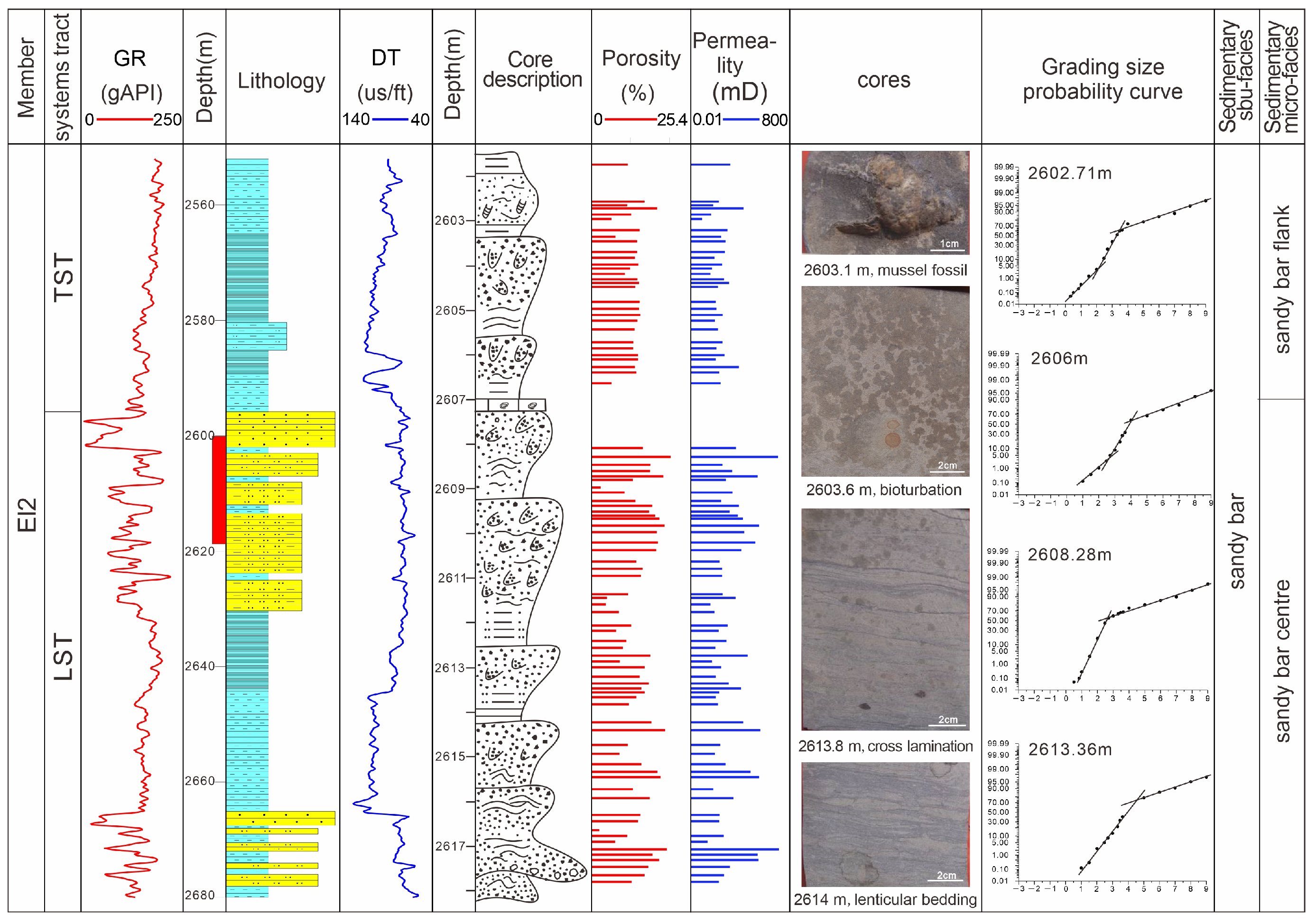
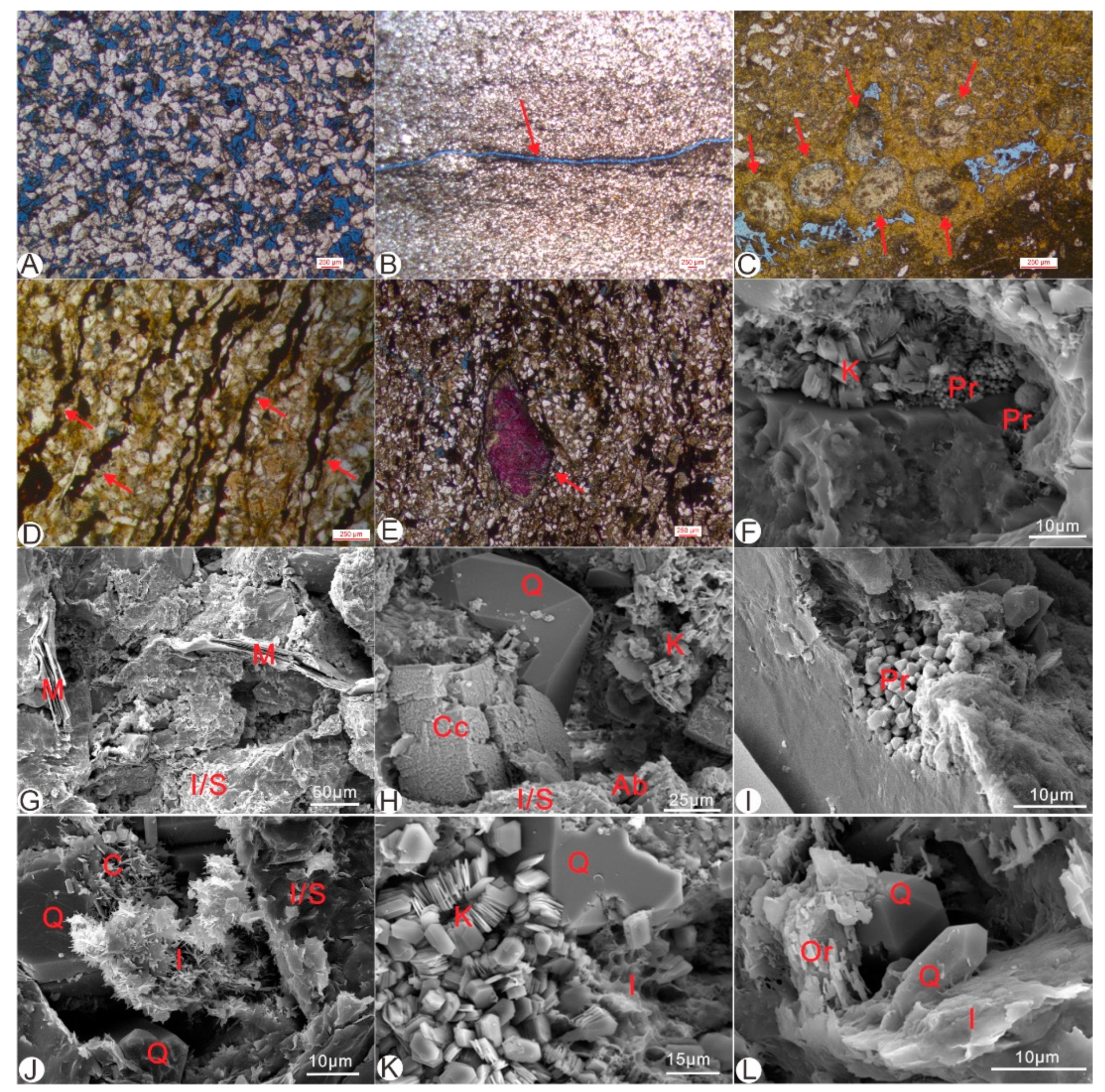
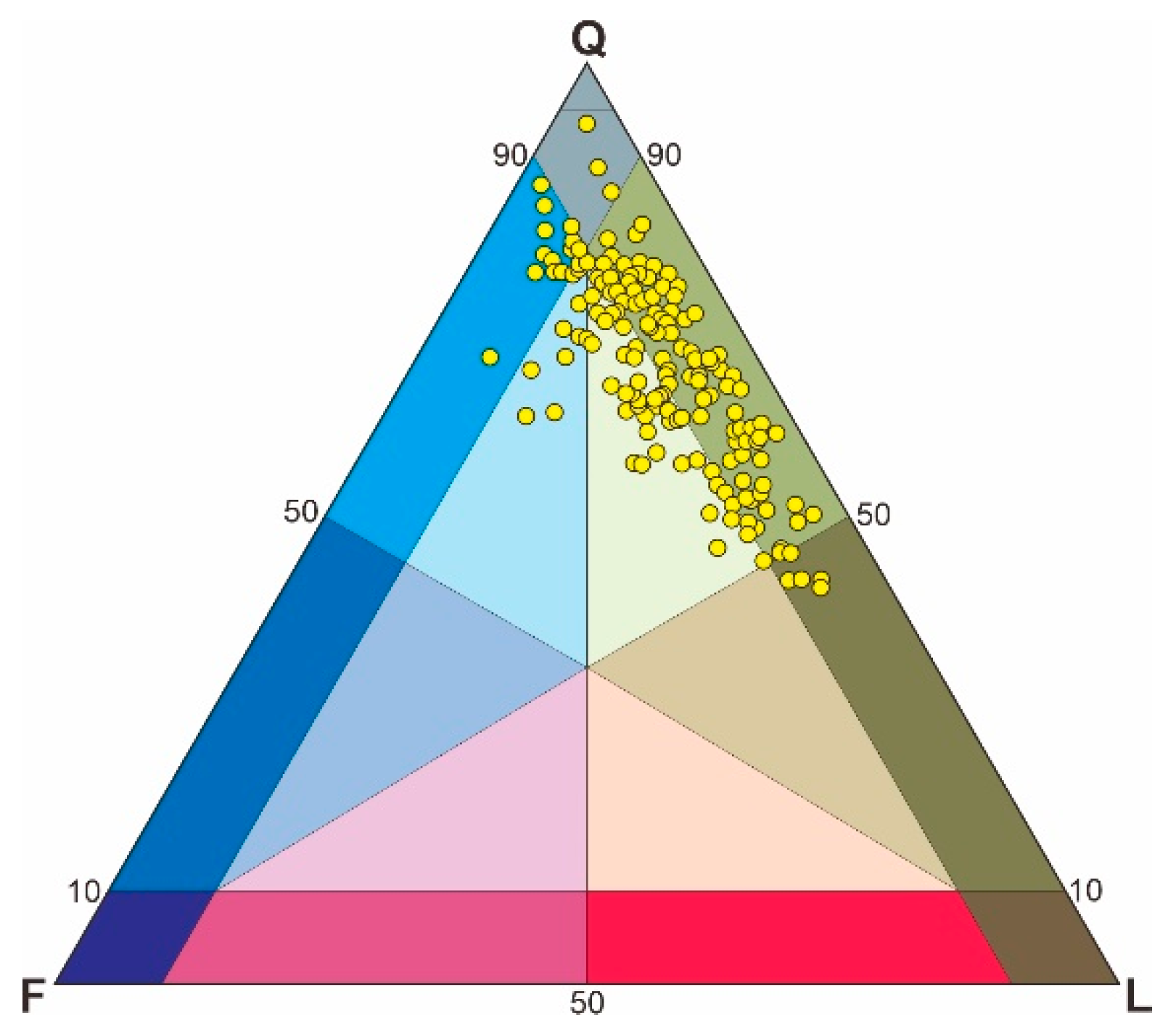
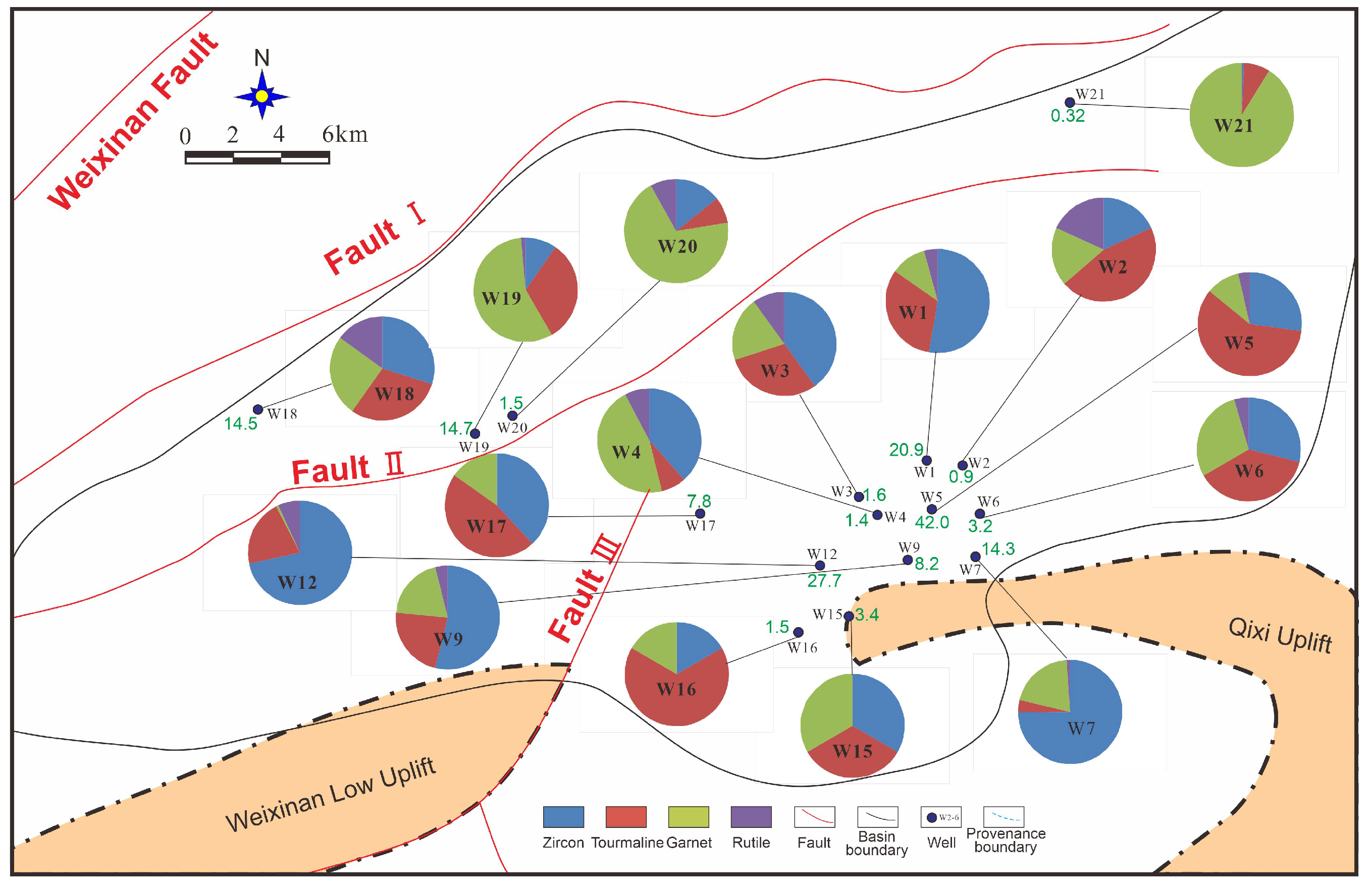


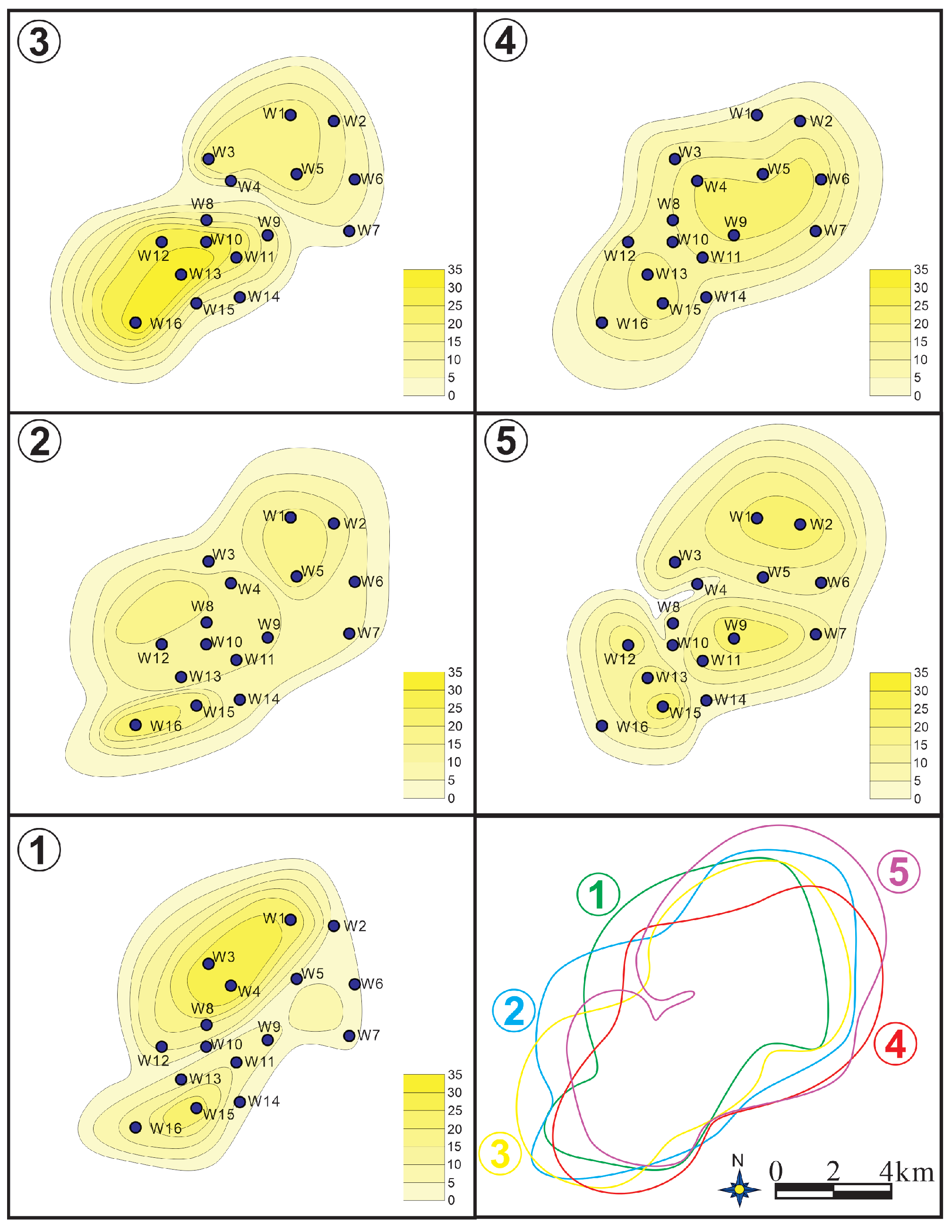
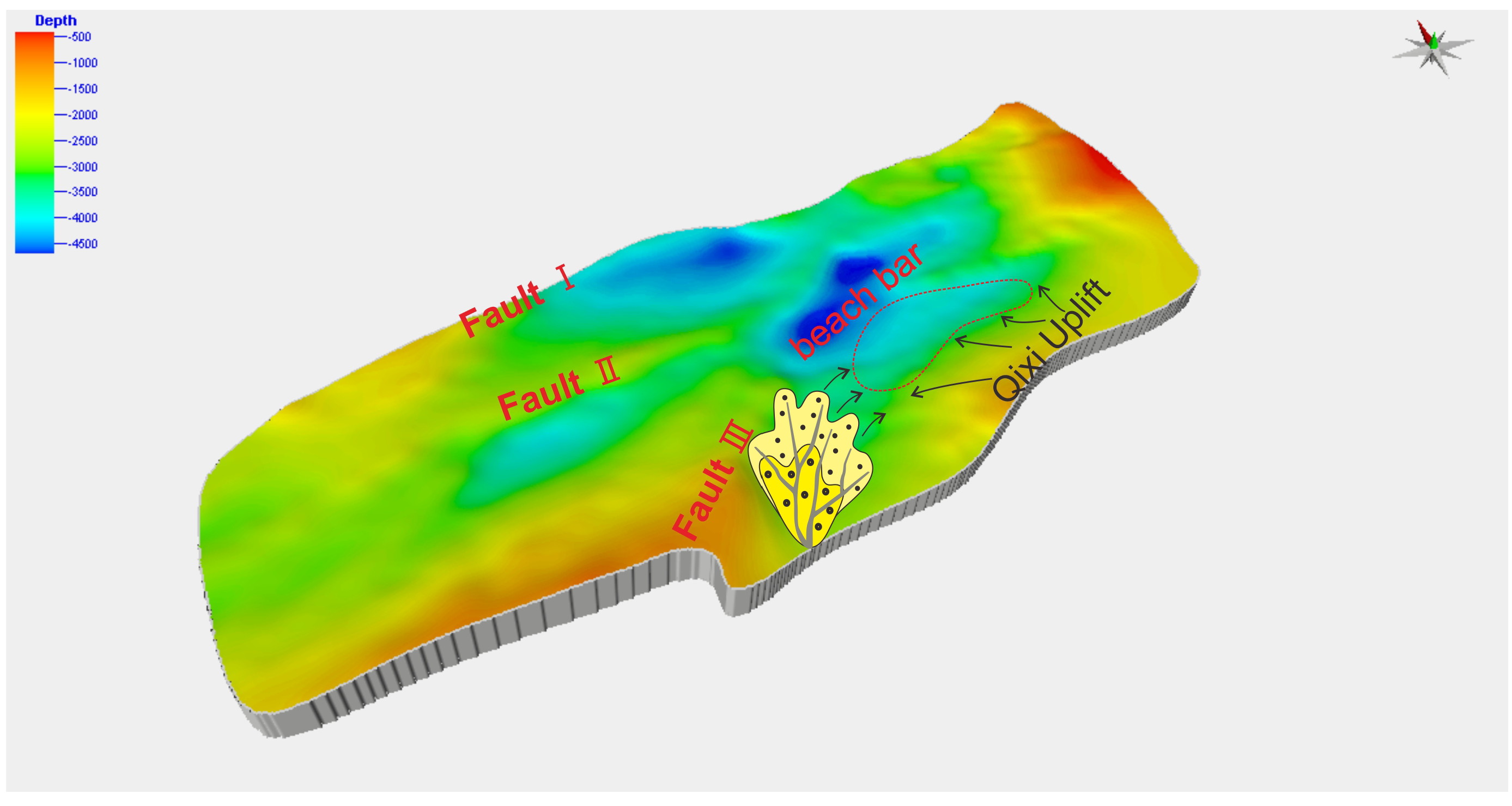


Publisher’s Note: MDPI stays neutral with regard to jurisdictional claims in published maps and institutional affiliations. |
© 2022 by the authors. Licensee MDPI, Basel, Switzerland. This article is an open access article distributed under the terms and conditions of the Creative Commons Attribution (CC BY) license (https://creativecommons.org/licenses/by/4.0/).
Share and Cite
He, J.; Wang, H.; Jiang, T.; Liu, E.; Chen, S.; Jiang, P. Sedimentary Characteristics of Lacustrine Beach-Bars and Their Formation in the Paleogene Weixinan Sag of Beibuwan Basin, Northern South China Sea. Energies 2022, 15, 3391. https://doi.org/10.3390/en15093391
He J, Wang H, Jiang T, Liu E, Chen S, Jiang P. Sedimentary Characteristics of Lacustrine Beach-Bars and Their Formation in the Paleogene Weixinan Sag of Beibuwan Basin, Northern South China Sea. Energies. 2022; 15(9):3391. https://doi.org/10.3390/en15093391
Chicago/Turabian StyleHe, Jie, Hua Wang, Tao Jiang, Entao Liu, Si Chen, and Ping Jiang. 2022. "Sedimentary Characteristics of Lacustrine Beach-Bars and Their Formation in the Paleogene Weixinan Sag of Beibuwan Basin, Northern South China Sea" Energies 15, no. 9: 3391. https://doi.org/10.3390/en15093391
APA StyleHe, J., Wang, H., Jiang, T., Liu, E., Chen, S., & Jiang, P. (2022). Sedimentary Characteristics of Lacustrine Beach-Bars and Their Formation in the Paleogene Weixinan Sag of Beibuwan Basin, Northern South China Sea. Energies, 15(9), 3391. https://doi.org/10.3390/en15093391








